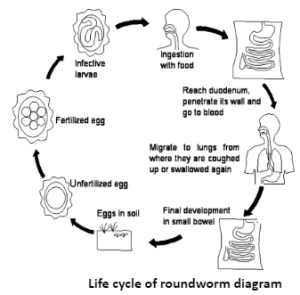A roundworm is also known as Ascaris lumbricoides. It is a nematode roundworm and belongs to the family Ascarididae. Roundworms are endoparasites found in human beings, pigs, sheeps, cattle, and so on. It generally lives inside our small intestine, where it feeds on semi-digested food. Here, it can grow up to a length of more than 30 centimetres. Roundworms are mostly found in children compared to adults.Roundworms need only one host to complete their life cycle (monogenetic). They can cause a disease called Ascariasis. Adults are not much affected by this disease, but in children it can lead to malnutrition and digestion problems. There are about 2 billion people affected by roundworms across the globe.
Structure of a roundworm
- Their body is bilaterally symmetrical
- They possess a pseudocoelom
- Sexes are separate and the males are shorter than females.
- Their alimentary system is fully developed.
- They have an excretory pore for waste excretion.
Stages in the life cycle of a roundworm
Stage 1: The egg stage
- The adult worm lives inside the small intestine.
- The female roundworm produces around 20,000-2,00,000 eggs per day. These eggs are released in the environment through human faeces.
- The unfertilised eggs may be ingested and remain inside the human body but become ineffective and do not develop.
- The fertilised eggs can vary in their shape from oval to round. The zygote is composed of a thick inner shell.
- The further development depends on the moisture, temperature and oxygen tension.
- If there is inadequate moisture and oxygen supply, and high temperature, the further development of fertilised eggs stops.
Stage 2: Cleavage and the development of the egg
- The fertilised eggs form a spiral and determinate types of cleavage.
- Dorsal and ventral cells are formed after the first division.
- Then an anterior and a posterior cell is formed by the division of the dorsal cell, and an upper and a lower cell is formed by the division of the ventral cell.
- Following this, the four-cell embryo is transformed into a 16-celled embryo, which is referred to as a blastula. This blastula attains the form of a hollow ball.
- The blastula then becomes the gastrula.
Stage 3: The larva stage
- The fertilised egg forms a larva.
- It remains infectious after 18 days. The infection time period is dependent on soil moisture and temperature.
- When a man swallows the egg containing the Rhabditoid larva with improperly cooked vegetables, raw vegetables or with water, he becomes infected.
- These larvae start hatching inside the man’s stomach but most of the time hatching continues in the duodenum of the intestine.
- The larva can also reach the lungs and can mature there also in about 10 to 14 days.
- The larva can reach the liver and can finally reach the heart through the post caval vein. From there it can reach the lungs through the pulmonary arteries.
- In the lungs it ruptures its way out of the blood capillaries and finally targets itself into the alveolar cells in the lung.
Stage 4: The adult stage
- With the help of the digestive juices inside the small intestine, the egg cells of the larva dissolve and the embryo hatches out.
- The larva develops into an adult worm.
- Adult worms become capable of producing a large number of eggs. They become sexually mature in about 6 to 10 weeks.
- The female worms start discharging eggs in the faeces of human beings within two months from the day the infection began.
- Adult Ascaris worms can live inside the small intestine of the human body for one to two years.

Life cycle of roundworm diagram
Symptoms of Ascariasis
- Vomiting
- Nausea
- Abdominal pain
- Abdominal distention
- Loss of weight
- Diarrhea
- Stunted growth
- Appendicitis
- Loss of appetite
- Shortness of breath
Prevention of Ascariasis
- The best way to prevent this disease is to maintain good health and hygiene.
- We should eat clean fruits and vegetables, and wash our hands before eating.
- Unwashed raw fruits and vegetables should be avoided.
Treatment of Ascariasis
- Anti-parasitic medicines are taken for the treatment of Ascariasis.
- In severe cases, surgery is required to remove the worms.
Conclusion
The roundworm (Ascaris lumbricoides) is a nematode roundworm and belongs to the family Ascarididae. Human beings are generally affected by roundworms when they swallow the egg containing the Rhabditoid larva with improperly cooked vegetables, raw vegetables or with water.
A roundworm needs only one host to complete its life cycle (monogenetic). It can cause a disease called Ascariasis. The adult worm lives inside the small intestine. The best way to prevent the Ascariasis disease caused by roundworms is to maintain good health and hygiene.
 Profile
Profile Settings
Settings Refer your friends
Refer your friends Sign out
Sign out






